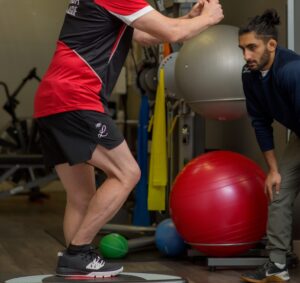Chronic pain—a phrase that millions of people across the globe know all too well. Chronic pain is not just a symptom. It’s a constant companion that affects every aspect of life. But what if there were ways to manage and potentially reduce this pain? What if you could address root causes instead of masking pain with medication? This blog post will explore the nature of chronic pain, its causes, and holistic approaches to treatment that go beyond traditional medicine.
Understanding Chronic Pain
Chronic pain is pain that persists for more than three months, often despite medication or treatment. It can stem from various conditions, including arthritis, back problems, migraines, or countless other health issues. Unlike acute pain—a body’s method of signalling harm—chronic pain can linger long after the injury has healed. Chronic pain hints at the complex interplay between the body and the brain.
The Terrible Triad: Suffering, Sleeplessness, Sadness
Chronic pain often brings along unwelcome companions—suffering, sleeplessness, and sadness, forming a ‘terrible triad‘. This triad creates a vicious cycle where pain worsens sleeplessness and sadness, which in turn can increase the perception of pain. Understanding this interconnection is crucial in managing chronic pain effectively.

The Brain’s Role in Chronic Pain
The brain plays a pivotal role in the perception and variation of pain. It acts as the central processing unit where pain signals are interpreted and experienced. Far from being a simple response to physical injury, pain involves complex exchanges between neural pathways. When an injured part of the body pain sends a pain signal, it travels through the nervous system to the brain. Here, the thalamus, cortex, and limbic system, analyze the signal, and process pain’s emotional and cognitive aspects.
This means that your emotional state, cultural background, and earlier experiences can significantly influence how you feel and manage pain. Furthermore, the brain can lessen the perception of pain by releasing natural painkillers, such as endorphins. The brain plays a critical role in the perception of pain and the body’s ability to suppress it. Understanding the brain’s role in pain perception opens avenues for new pain management strategies. Incorporating strategies that target neural systems, offers hope for chronic pain sufferers.
Seeking Natural Relief for Chronic Pain
For those who have been through the wringer of medical treatments and are wary of the side effects of traditional pain medications, there’s hope in natural therapies. These treatments aim to relieve pain and restore overall well-being.
Physiotherapy
Physiotherapy offers a pathway to improved quality of life through expert-led, personalized treatment plans. This science-backed approach addresses the discomfort and dives into the root causes of chronic pain. By integrating various techniques, from manual therapy to tailored exercise programs and education on body mechanics, physiotherapy empowers individuals with the tools they need to manage their pain effectively. It’s about more than symptom relief; it’s about fostering a partnership between patient and therapist to build a foundation for a more active and pain-free lifestyle. Through an empathetic and educational lens, physiotherapy helps patients understand their body and take proactive steps towards health.

Chiropractic Care
Chiropractic care is both holistic and non-invasive. At the heart of this practice is a profound understanding of the body’s intricate systems and how they can be harmonized for health. Chiropractic treatments can alleviate pain by improving the functional mobility of the joints and spine, reducing nerve irritation. This method addresses the symptoms and targets the underlying issues, fostering a healing environment within the body. If you need a break from the relentless grip of chronic pain, chiropractic care offers a promise. Chiropractors help patients reclaim control over their well-being, emphasizing the body’s innate ability for self-healing and resilience.
Acupuncture
Acupuncture involves the insertion of ultra-thin needles into specific points on the body. Researchers believe this technique stimulates the nervous system and activates the release of the body’s natural painkillers. For many sufferers of chronic conditions, such as arthritis, back pain, and migraines, acupuncture offers a pathway to relief without the reliance on pharmaceuticals. By engaging the body’s healing mechanisms, acupuncture reduces pain and improves overall well-being. It’s a testament to the power of integrating traditional healing practices with modern medical understanding, empowering individuals to explore alternative, non-invasive options for pain management.

Manual Osteopathy
Manual Osteopathy is a hands-on approach to healthcare emphasizes the body’s innate ability to heal, focusing on restoring balance and promoting overall wellness. Practitioners engage with the body’s structure and function to alleviate pain and enhance mobility. This method addresses the symptoms and dives deep to find and treat the root causes of pain. By adopting a holistic perspective, osteopathy empowers individuals, offering them a pathway to reclaim their quality of life without relying solely on medication.
Naturopathic Medicine
Naturopathic doctors are playing an increasingly pivotal role in the lives of those suffering from chronic pain, where traditional medicine often reaches its limits. By considering the entire individual—physically, emotionally, and mentally—naturopathy seeks to ease symptoms, identify and treat the root causes of pain. This method differs from the conventional model, focusing on symptom management often through pharmaceuticals, which can sometimes lead to dependency or unwanted side effects. Through personalized treatment plans that may include dietary changes, herbal medicine, physical therapies, and stress reduction techniques, naturopathic doctors empower patients to take charge of their health and well-being.

Massage Therapy
Massage therapy goes beyond mere relaxation, targeting the root of pain to foster healing and provide relief. By improving circulation, massage therapy helps the body’s natural recovery process, nourishing tissues starved of nutrients and oxygen due to prolonged tension and inflammation. Furthermore, it plays a crucial role in releasing endorphins, the body’s natural painkillers. Significantly, it also aids in reducing stress and anxiety, which are often intertwined with chronic pain. Through skilled manipulation of muscles and tissues, massage therapy alleviates discomfort. It empowers individuals to engage more fully in their daily activities, improving their quality of life.
Counselling
Psychotherapy and hypnotherapy can address the emotional and psychological aspects of chronic pain, breaking the cycle of the ‘terrible triad.’ Chronic pain is a complex and multifaceted condition, changing the physical body and the emotional and psychological well-being of those affected. Counselling offers a vital lifeline, providing strategies and support to help individuals cope more effectively with their pain. It goes beyond symptom management, addressing the profound emotional strain that chronic pain can impose. Through counselling, patients learn resilience-building techniques, mindfulness practices, and cognitive-behavioural strategies, empowering them to reclaim their lives from the clutches of pain.

Nutritional Counselling
For individuals grappling with chronic pain, the search for relief often leads down various paths, from medication to physical therapy. Yet, one avenue that may not be immediately obvious is nutritional counselling. Healthcare professionals are increasingly recognizing that our food can profoundly affect our body’s inflammatory processes and pain response. By working with an expert who understands the complex relationship between diet and chronic pain, sufferers can learn how to make informed dietary choices.
Food is medicine. Certain foods help reduce inflammation, enhance healing, and alleviate some of the discomfort associated with chronic conditions. This method does not stand as a solitary solution but rather complements other treatments, offering a holistic strategy to empower individuals to control their health and well-being. Through education and personalized guidance, nutritional counselling is vital in managing chronic pain, underscoring the significant role that diet plays in our overall physical health.
A Personal Journey of Managing Chronic Pain
Consider the story of a 70-year-old woman who walked into Newleaf Total Wellness Centre, lost and overwhelmed by three decades of chronic pain. After her physician left his practice and closed his clinic, she was suffering from medication withdrawals, and was desperate for a new approach. At Newleaf, she found a team ready to listen and tailor a comprehensive plan to address her pain holistically. Today, she enjoys a clearer mind and a more manageable pain level, proving it’s never too late to seek help and regain control over one’s life.

How Newleaf Can Help Combat Chronic Pain
At Newleaf Total Wellness Centre, we understand that every chronic pain sufferer’s story is unique. Our interdisciplinary approach, founded on patient-centred care, combines various treatments to help our patients become stronger, braver, and better. Whether at the beginning of your pain management journey or seeking alternative therapies, our team guides you toward a higher quality of life. It doesn’t matter where you start. Take the first step, and we will guide the ones that follow.
If you or someone you know is struggling with chronic pain, remember there is hope. Holistic approaches to pain management can offer relief and a pathway to a more vibrant, fulfilling life. Book a consultation to learn more.
Written By: DeVera Nybo, MBA, Owner, Newleaf Total Wellness Centre

